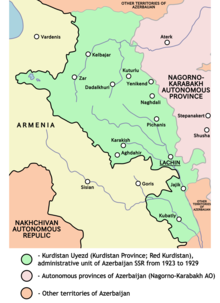Deportations of Kurds from Transcaucasia
This article relies largely or entirely on a single source. (April 2024) |
In 1937 the Kurds were deported from Azerbaijan SSR and Armenian SSR. In 1944 the Kurds of Georgian SSR were also sent to the "special colonies", including those in Siberia, and were resettled there. Most adult males were deported separately from females and children with their fate unknown.[1]

Ismet Cheriff Vanly emphasizes that "the deportations of 1937 were quite unrelated to the Second World War or its anticipation. Nor can the deportation of 1944 be connected with the war. In this respect they differ from the cases of the Crimean Tatars and the Volga Germans". He refers to Professor Shakero Mihoyi, according to whom the deportations transpired at the instigation of Mir Jafar Baghirov, the Azerbaijani government's leader, who maintained close connections with Stalin and the OGPU. Vanly continues that "[w]hile this may be true in the case of the Kurds deported from Azerbaijan, it fails to explain why Armenia and Georgia followed suit". He writes that it appears that the deportations were instigated by pressure from Turkey, as Turkey was concurrently engaged in the deportation of its Kurdish populace.[2]
Not all Transcaucasian Kurds were subjected to deportation for resettlement in Kazakhstan, Kirghizia, Tajikistan, Uzbekistan, and Siberia. Some among them were able to eventually return to Transcaucasia. However, the precise figures regarding the deported population remain unknown.[1]
According to Vanly's calculations, "in 1990 […] the four districts of Kurdistan might have a total population of 300±350,000 of whom some two-thirds would be Kurdish, and in Transcaucasia as a whole Kurds would have numbered close to one million, including 500,000 in Azerbaijan, had it not been for deportations and other forms of persecution".[2]
The census data from 1970, which recorded 88,930 Kurds in Soviet Union, reflects, together with the manipulation of the figures, the fact of mass deportation of Kurds. Vanly criticizes the explanation of Soviet philologist Magomet Isayev that the reason for the sharp decline in the number of Kurds in the census was their "assimilation", because they were "scattered among several other nationalities", as a "typical Soviet euphemism for the forcible deportations of 1937 and 1944 and the resettlement in Soviet republics largely in Central Asia".[2]
Among the deported Kuds were Nadir Nadirov (from the Azerbaijan SSR)[1] and Arab Shamilov (from the Armenian SSR).[3]
Vanly places responsibility for the enforced deportations of the Kurds on Stalin and Baghirov and their adherents.[4]
Legacy[edit]
Under Mikhail Gorbachev, Kurds from different republics of the USSR held rallies. On May 20, 1989, a sizable and well-organized demonstration conducted by Kurds occurred in Moscow's Pushkin Square. Representing groups from nine Soviet republics, the demonstrators subsequently marched to Ismailovsky Park the following day, as documented by Soviet media outlets, including television. Particularly notable among the demonstrators were women from the Central Asian republics, where the majority of adult Kurds are female due to the forced deportations and disappearances of their male relatives over the preceding fifty years. Their spokeswoman, Mezihe Ghefûr, made the statement about legacy of Kurdish deportations and the problems of the Kurds in the USSR.[5]
On August 17, 1989, the Supreme Soviet enacted a law stipulating the repatriation of all Soviet citizens who had been subjected to deportation during Stalin's regime, with the restoration of their previous rights. Nevertheless, its implementation faced significant challenges. While certain groups, like the Volga Germans, were able to return to a welcoming homeland, for others such as the Crimean Tatars and the Kurds, their original territories had been colonized by Russians, and in the case of Kurds, by Azerbaijanis, posing serious barriers to their return.[6]
References[edit]
- ^ a b c Vanly (1992), p. 160.
- ^ a b c Vanly (1992), p. 162.
- ^ Vanly (1992), p. 165.
- ^ Vanly (1992), p. 166.
- ^ Vanly (1992), p. 168.
- ^ Vanly (1992), p. 169.
Sources[edit]
- Vanly, Ismet Cheriff (1992). Kreyenbroek, Philip G.; Sperl, Stefan (eds.). The Kurds: A Contemporary Overview. Routledge. ISBN 0-203-99341-1.
Further reading[edit]
- Goff, Krista A. (2021). Nested Nationalism: Making and Unmaking Nations in the Soviet Caucasus. Ithaca, NY: Cornell University Press. ISBN 9781501753275.
